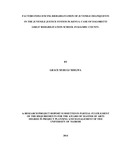| dc.description.abstract | The purpose of this study was to investigate the factors influencing rehabilitation of juvenile delinquents in the juvenile justice system in Kenya. The study was carried out in a government rehabilitation school in Kiambu County which is Dagoretti girl’s rehabilitation school. The objectives of the study were to examine how guidelines existing in children’s courts influence the rehabilitation process of juvenile delinquents, determine how the competence level of the staff handling juvenile delinquents in the Kenyan rehabilitation schools influences rehabilitation of juvenile delinquents, examine how the environmental settings of rehabilitation schools in Kenya influence the rehabilitation of juvenile delinquents and to investigate the influence of family involvement and the rehabilitative process of juvenile delinquents. Overall, the study intended to investigate how these factors affect the rehabilitation of juvenile delinquents committed to this institution by looking at both short and long term benefits of the rehabilitation process to juvenile delinquents. Other studies have been carried out at individual and institutional levels some of which recommended further studies as regards to rehabilitation of juvenile delinquents which was the basis of this study. The study used a descriptive survey design. The target population was the 2nd and 3rd year juvenile delinquents, welfare officers, class teachers and vocational training instructors from the institution. A sample size of 50 juveniles and 8 key informants was purposively selected making it a total of 58 respondents. The data for the study was collected using questionnaires, interview schedules and focus group discussion. The data was analyzed descriptively using excel, word and Statistical Package for Social Sciences and was presented in frequency tables and prose form. The findings indicated that the variables studied were significant in determining the effectiveness of the rehabilitation process. The findings showed that most of the guidelines stipulated in national and international legal instruments with regards to children are not adhered to in the children’s court. Findings on the court process showed that 80.6% of the children were detained between one week and four months, most of them were not given explanations for their arrest and majority did not have legal representation. This showed a laxity in the protection of children’s rights in the children’s court which is one of the agencies in the juvenile justice system and a deterrent to the rehabilitation process of the juveniles. The level of staff competence also influences the rehabilitation process but on the positive. 81.3% of the staff were rated at good and above and some of the staff were mentioned as role models. The findings indicated the greatest hindrance to the rehabilitation process was the environmental settings of the school. The buildings were very old and had cracks on the roofs and floors. The beds were inadequate and some of the children cited cases of sleeping on the floor. The workshops and classrooms had inadequate facilities and classes 1, 2, 3 and 5 were missing. On the level of family involvement and how it influences the rehabilitation process, the findings indicated that 50% of the parents had never visited the juveniles in the rehabilitation school which made them feel that they are not loved. To improve the effectiveness of the rehabilitation process, the government should work together with all stakeholders to synchronize the whole juvenile justice system; the government should also improve on the physical conditions of the rehabilitation schools and ensure that rehabilitation staff have adequate training. The management of the institutions should also formulate a programme for family visitations and mediation. | en_US |

